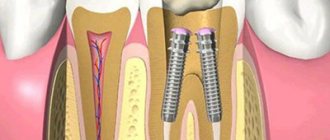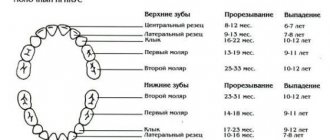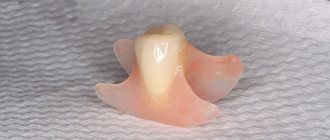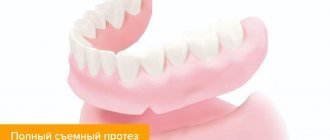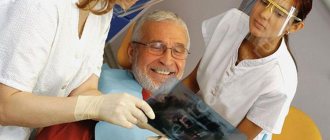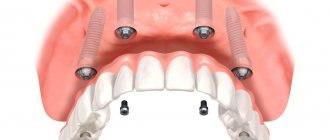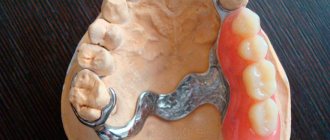In modern dentistry, many different methods are used to restore the dentition in case of partial or complete loss of its units. The choice of technology depends, in particular, on the timing of dental prosthetics. The difference in the duration of treatment can be up to several months, depending on how soon and how high-quality the patient wants to get.
Timing of prosthetics on implants
If the patient chose implantation to restore teeth, the final stage may occur in six months or longer. This is due to the fact that before the installation of prostheses you have to undergo several procedures and operations. In particular, when using the classical technique, before obtaining the final result it is necessary:
- insert artificial roots into the jaw - implants;
- wait until the rods are overgrown with bone tissue and stabilized;
- undergo the second surgical stage of implantation to install the former;
- after two weeks, install the abutment and take impressions to make the crown;
- do a fitting and, if necessary, correction of the prosthesis.
After all these manipulations, the time comes to install a permanent artificial tooth. The general time frame for prosthetics, including implantation, in this case can range from four to seven months.
Functions of immediate dentures
The most important functions of immediate dentures include:
- ensuring accelerated healing of tissue damaged during tooth extraction;
- preventing the formation of bone exostoses, which make it impossible to use any removable prosthetic structures;
- complete restoration of the aesthetic and functional properties of the dental system immediately after surgery;
- prevention of atrophy of the alveolar processes and alveolar ridges;
- creating favorable conditions for the gradual formation of a prosthetic bed;
- eliminating the risk of healthy teeth shifting towards the removed ones;
- adaptation of the gums to the upcoming load associated with wearing a permanent prosthesis;
- relieving the patient of psychological discomfort caused by the presence of defects in the dentition.
Prosthetics in complex cases
The duration of treatment, or rather the timing of prosthetics, may increase even more if additional surgical procedures are necessary. For example, to install a crown or bridge on implants, bone tissue augmentation may be necessary, since its volume is not enough for the full “implantation” of a titanium root. In some clinical situations, it is also necessary to perform gum grafting, which requires additional time.
It is sometimes possible to install a prosthesis in such difficult conditions only after a year. This is due to the fact that you first have to wait until the bone material takes root. Then install the implant and allocate time for osseointegration (overgrowth of the rod with bone tissue). And only then will the production of the prosthetic structure begin. It is impossible to speed up treatment in such situations due to certain biological “laws” that no dentist can change. The fusion of bone tissue particles requires a certain time and this must be accepted and taken into account.
Materials for dental prosthetics
Various materials are used to make dentures. These can be various metals, plastics, nylon, composite materials, cermets and ceramics.
Safe, but very expensive are gold, as well as alloys of palladium or platinum. These materials are perfect for ceramic inserts.
Some alloys, on the contrary, can cause allergies. Like, for example, an alloy of chromium and nickel or cobalt. Although it is worth noting that these materials also have their advantages.
Zirconium oxide looks attractive . This material is perfect for front teeth. Titanium is one of the best options for dental prosthetics. It is biologically neutral, does not cause allergies and is wear-resistant.
An inexpensive, accessible and reliable material is plastic . Despite many advantages, plastic also has its disadvantages. This material absorbs odors and changes color when exposed to dyes and bacteria in the oral cavity.
Nylon is becoming increasingly popular. It is reliable in operation, fastens well and is completely harmless. Nylon is not subject to deformation and is resistant to moisture. This is an excellent choice of material for prosthetics.
Ceramics is a material that is very similar to natural teeth. With its help you can hide imperfections. Metal ceramics have greater strength and are much more reliable; they are not afraid of mechanical loads.
Composite materials are used to give the tooth the required shape. They represent polymer compounds. With their help you can restore a tooth.
Time frames for manufacturing and installation of prostheses based on natural teeth
The choice of simpler prosthetic methods is usually explained by the desire to reduce the cost of treatment, as well as install crowns or bridges as quickly as possible. In this case, new teeth can be obtained in just a few days or a couple of weeks. This is exactly what is required to:
- treat, depulpate and prepare supporting units;
- take impressions, on the basis of which a crown or bridge will be made in the laboratory;
- try on and adjust the new design;
- install the prosthesis on the stump of the abutment tooth.
Modern progressive methods make it possible to restore a damaged tooth in one day. We are talking about using computer technology to design and manufacture a prosthesis in just a few hours, right in the dentist’s office. Such a crown is machined with high precision in a special milling machine, after which it undergoes finishing processing and is installed on the abutment tooth.
How is a removable denture fixed?
- A single or partial denture sits on hooks that secure the base to the existing teeth.
- A removable denture that does not cover the palate is fixed to the teeth using a beam type.
- In case of complete absence of teeth, removable dentures are attached using vacuum technology, that is, on suction cups. If for objective reasons (technical, physiological) this is impossible, creams and gel compositions are used to attach removable dentures to a toothless jaw.
- Removable dentures that do not cover the palate are securely attached using ball-shaped locking mechanisms. The hooks are placed on screwed-in titanium pins, core elements, or the roots of existing teeth.
Note! As practice shows, with complete edentia and replacement of teeth with a removable denture, it is necessary that the edges of the base form a dense final contour. This is necessary so that when put on, no air remains between the mucous membrane and the base of the prosthesis, causing the structure to fall out.
Terms of removable prosthetics
The manufacture of removable structures also requires some time. First, the dentist takes impressions of the jaws and sends them to the laboratory. Then it takes two to three days to make the models, after which the first fitting is carried out. About three to five more working days are required to produce the future prosthesis. After trying it on and fitting it takes about a week. The patient then tries on the design again and, if necessary, adjustments are made again. Thus, the production of removable orthopedic structures takes an average of three weeks.
Features of human adaptation to individual removable dentures
- Considering the prospects for getting used to removable dentures, we highlight several options for the development of events:
- For example, a removable acrylic denture or a nylon analogue is made of high quality.
- The removable denture did not fit the patient.
Then the dentist-prosthetist recommends performing articulatory gymnastics techniques daily, in particular, paying attention to the pronunciation of the sounds: “sh”, “sch”, “ch” with the prosthesis already installed in the cavity.
In addition, it is important that enough time has passed (about 30 - 40 days) after prosthetics - a dense contour of the gum should appear, and the removable denture should be “built into” the gum, going deeper by one to one and a half millimeters. In order for the adaptation process of a removable denture to occur more actively, patients are recommended to suck lollipops (preferably “sugar free”), but not jelly candies. At the initial stage, after installing a removable denture, it is more beneficial to completely avoid eating viscous foods, so as not to provoke loosening of the structure or its sudden loss.
Once the prosthesis is in place, the dentist can make periodic adjustments. For example, within two months it is necessary to remove part of the base that rubs the gum tissue. Standard dental correction of a removable denture is carried out within a year after installation of the system.
Even at the stage of installing a removable denture, the dentist-prosthetist demonstrates how to properly install, remove, and clean it.
Absolute adaptation of a removable denture occurs two to three months after the start of wearing.
A removable denture is a foreign structure, which should take at least 30 days to get used to. Sometimes patients need three months to get used to it, learn to articulate, get used to chewing food, and not have problems smiling and talking with a removable denture.
To correct the situation, you need to undergo additional consultations at other dental centers. As dental practice shows, if a removable denture is made poorly, a new one needs to be made. For example, Zuub specialists will help determine what the problem is and, if necessary, help correct inaccuracies in the removable denture so that you can wear a high-quality and reliable removable denture.
If manufactured incorrectly, the base does not adhere well to the mucous membrane, the removable denture becomes loose, gaps are visually noticeable, and there are problems with pronouncing individual sounds and chewing foods.
Prosthetics: everything you need to know
Inna Ch., patient of the “Private Practice of Irina Zaitseva” clinic: “For a very long time I did not decide to get dental prosthetics, although there was already a need - I kept remembering my grandmother’s “teeth in a glass”. It turned out that this option is an extreme option. There are other modern options for prosthetics. But if I had delayed this issue any longer, I would have really had to put my teeth in a glass.”
The first step is for the dentist to find out which teeth need to be replaced or replaced with dentures. This is possible only after all the necessary surgical and therapeutic procedures have been completed to ensure that the condition of the teeth and gums can be characterized as completely healthy. That is, you first need to treat the teeth that can still be saved, and remove those that, unfortunately, are too late to save. Also, if necessary, it will be necessary to carry out periodontal treatment - the tissues surrounding the tooth.
Then the doctor develops a prosthetics strategy, explains to the patient what types of prostheses can be installed, and what advantages and disadvantages each option has. Only after making sure that the patient clearly understands what awaits him does the doctor proceed to the actual process of prosthetics.
What are the most modern prosthetic methods?
Modern prosthetics are divided into fixed and removable.
Fixed dentures are attached to healthy teeth or implants. For this purpose, so-called bridges are used - metal arches to which artificial teeth are attached. This type of prosthesis includes crowns, as well as microprostheses - inlays, onlays, veneers.
The name “removable dentures” speaks for itself. Support and fastening are not necessary for them. Therefore, they can replace all the teeth in the mouth. This also includes partial removable dentures or clasp structures (the name comes from the German word bügel - arc). They are similar to bridges with one difference: the clasp structures can be removed.
Removable dentures have virtually no contraindications. However, when using them, the chewing load falls on the gums. Therefore, this type of prosthetics is considered a non-physiological way to compensate for the chewing function, and is used only as a last resort.
Bridges are also considered non-physiological. Therefore, the aesthetic dentistry clinic “Private Practice of Irina Zaitseva” tries not to offer them to patients.
To summarize all of the above, today the most optimal type of prosthetics is single crowns.
About 70% of cases of prosthetics in Russia are removable dentures. While in Europe they are placed only in 10-15% of cases. Russians turn to dentists for help too late, sometimes when there is nothing left to chew. The earlier the treatment occurs, the more comfortable and economical prosthetic option can be selected.
What are dentures made of?
Today, a wide range of materials is used in the production of dentures: metals, ceramics, porcelain, zirconium, acrylic photopolymers, various types of plastic, composite materials. All of them are hypoallergenic and completely safe for the patient’s health.
What should a high-quality denture look like?
A high-quality prosthesis should have the following characteristics:
- high fracture strength
- high resistance to abrasion
- high color fastness.
- high aesthetic indicators (the prosthesis should look like a real tooth and even better).
How long will prosthetics take?
The modern procedure for dental prosthetics is a relatively short and completely painless process. However, this statement is true if prosthetics is not preceded by tooth extraction. In case of removal, it is necessary to wait for maximum shrinkage of the bone tissue, which will take at least 2.5–3 months. More with multiple deletions. At this time, the patient uses temporary prostheses, which include crowns and clasp dentures.
How necessary is it to install temporary dentures?
Some may think that temporary dentures are a waste of money. You can walk like this, be patient. This is wrong. Here are some reasons why you need to install them:
- To prevent infection (infection) of a tooth ground for installation of dentures, and to reduce its sensitivity to hot and cold, it is necessary to cover it with protection. Such protection is provided by temporary crowns made of plastic.
- Temporary crowns and dentures are needed to maintain quality of life and ensure chewing function during the healing period.
- Temporary crowns are also needed as an aesthetic prototype for permanent crowns. Using their example, the length, size, color, and individual characteristics of permanent dentures are adjusted.
- Temporary crowns reproduce and maintain the height of the bite. This is important for complete reconstruction of the dentition.
How to care for dentures
Fixed dentures require a normal daily oral hygiene routine. In addition to it, doctors at Irina Zaitseva’s Private Practice strongly recommend using the WaterPik irrigator.
Removable dentures require a different approach. In addition to brushing, they should also be treated with a special solution. In addition, as soon as it becomes dirty, the prosthesis should be professionally cleaned at a dental clinic.
Which removable dentures are best?
Each of the dentures has its own competitive features, advantages and nuances:
- It is believed that nylon removable dentures are more comfortable for patients to wear, they are soft, bend well, and do not provoke allergies and irritation;
- if dropped on a hard surface, the base of nylon removable dentures will not be damaged, but acrylic analogues risk cracking;
- Also, acrylic dentures are much more durable, they are better fixed to the mucous membrane of the human oral cavity.
Each person may have personal characteristics in adapting the prosthesis. Thus, at the stage of planning prosthetics, a person does not yet know whether he will be satisfied with the aesthetics and quality of chewing food with the help of an installed removable denture. The listed factors are individual - everything comes in comparison and after some time, until the final adaptation to the removable denture occurs.
Of course, removable dentures are not as comfortable as dental implants and permanent bridges, but the latter two options are much more expensive. For older people, removable dentures are a reasonable and affordable solution to the problem of completely missing teeth.
Features of repair and restoration of removable dentures - experts answer
- When is it possible to repair a custom removable denture?
- Does a bonded removable denture lose its strength characteristics after prosthetics?
- Which prosthesis is better in terms of the comfort of removable denture repair?
- How often should dentures be replaced, even though they wear well and don’t break?
Provided that as a result of a fall or mechanical damage, the prosthesis can be aligned along the split. You can also repair a removable denture if one or a pair of teeth have fallen off the base.
Yes, he is losing it. Unfortunately, the removable denture will no longer be as reliable as it was originally, but with high-quality gluing it will last for some time. During this time, you can safely prepare to order a new removable denture.
Of course, nylon is better because it does not break or crack. But an acrylic removable denture is more fragile, but it is more reliable.
Experts advise making a new removable denture three to four years after its introduction. If the existing removable denture has been in the mouth for more than 5 years, and it has never broken in the past, you should plan to install a new one. The average lifespan of such structures is about five years.
Cost of removable dentures in Moscow
As dental practice demonstrates, removable dentures in Moscow are the most inexpensive. Also, removable dentures are officially included in the national compulsory health insurance program, and as a result, installing a removable denture is not at all expensive.
What affects the final cost of a removable denture?
- Type of base material chosen for a removable denture - after studying the price lists, you will be convinced that nylon options have a higher price than acrylic ones;
- The format for obtaining a plaster model of the jaw is in an occluder (a device that fixes the location of the model in central occlusion) or an articulator (a device that imitates the mechanism of operation of the mandibular joint). Models made using an articulator are slightly more expensive.
- Quality and quantity of dental art (teeth made of metal-ceramics, plastic, etc. are available to choose from).
- The level of qualification of the attending dentist who plans prosthetics and installs a removable denture;
- Level and authority of the dental clinic;
- Possible discounts, bonus programs for removable dentures. For regular clients, the clinic can make promotional offers on removable dentures.
The approximate price for removable acrylic dentures in Moscow is from ten thousand rubles.
The estimated cost of a removable denture in Moscow (nylon) is from twenty-two thousand rubles.
Dentistry "Zuub" specializes in dental prosthetics. We offer you inexpensive and high-quality removable dentures of all types (“butterflies”, complete, as well as single and partial).
